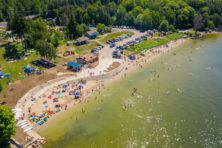Portrait of a Remediated Beach
- Share
- Tweet
- Pin
- Share

Egg Harbor Beach is located below a steep embankment where water runoff during rain events gushed freely down the hill, transporting all it encountered along the way into the beach water – fecal bacteria, heavy metals, oils, sediment and the phosphorus that causes algae growth and can result in fish kills.
“This was a high priority beach back then,” said Greg Coulthurst, Door County Soil and Water Conservation Department conservationist, and “one of the first beaches we worked on” to improve water quality.
Up until around 2009, it also challenged anyone’s definition of a “beach.”
“They had 13-15 people at the beach per hour and a rock jetty and tiny little beach and grass growing up in the beach,” said Greg Kleinheinz, University of Wisconsin-Oshkosh professor of environmental engineering technology. “Look at it now. It’s a hugely popular beach. Now hundreds of people are there.”
Having learned that surface and stormwater runoff were the primary culprits in beach water contamination, the improvements focused on creating grass infiltration areas to capture the water rushing down the hill. Also known as biofilters, these features are created with a sand and compost mixture installed a couple feet deep to create a bowl-like depression that can also host native beach plants.

“When the water runs down the slope, it’s diverted into the biofilter, which cleans the water naturally and reduces the volume before being released into the harbor,” said Andrew Schmidt, a municipal and water resources engineer with McMahon, who was a part of the project when it began.
There are two biofilters, the first installed with the original beach improvements in 2009, the second installed the next year with a low-lane curb to divert water more efficiently. The village also almost doubled its parking along the beach with 20 additional stalls, but used permeable pavers rather than impervious surfaces like asphalt. The special permeable gravel has a high tolerance for infiltrating through the material.
“They work pretty well,” Schmidt said. “Talking with the village, they’ve never seen any ponding, so that means the water is getting down and through.”

Native, prairie-type plantings were also widely used in the biofilters and as a screen for grassy areas beyond.
“They deter some of the waterfowl,” Schmidt said. “Waterfowl don’t like to walk through taller, thicker grasses, they like to walk on a nice clean beach area. So people who mow right up to the shoreline, that’s what geese like.”
The improvements were designed to prevent fecal bacteria from getting into the water, and also to filter all the other runoff pollutants that can impact water quality for fishing, swimming, recreation and wildlife. That has been, and continues to be, a priority for the village, said Egg Harbor Village Administrator Megan Sawyer, who has been with the village since 2016, first as deputy administrator. She said past and present village leadership has always recognized that waterfront is an integral part of Door County culture.
“They’ve done a great job of understanding the importance of the beach,” Sawyer said.
The Phase I improvements were followed by Phase II after the village purchased land north of the beach. Those 2018-19 improvements included the construction of a stone wall with native plantings along the top that again slows and stops the runoff, filters it, and provides a deterrent for the geese.

“If they see the grass they’re more likely to visit that grassy area,” Sawyer said. “So they took into consideration visual obstruction of the grass so as not to have more goose droppings that lead to E.coli.”
Last year, the village was one of five municipalities that agreed to install one of the new, cellular-connected water-quality signs that enable instant notification of beach advisories or closings. They’ve also invested in ongoing beach-maintenance equipment.
“Over the years we’ve been importing a lot of sand to add to the beach and purchased some grooming equipment,” said John Heller, village president. “We use it daily in the season. It sifts the sand and gets rid of stones and debris. We work hard on keeping the sand healthy and the biofilter helps with the runoff. It was well thought out.”
The village acquired a little over an acre of Alpine property in 2021 on the south side of the beach that includes a dilapidated pier the village is hoping to repair. They purchased the property to be able to move a pumping station off the beach.

“So we’re in the process of moving the lift station and possibly this spring, depending on the plans on the new lift station, we’ll tear down the old one and have one continuous beach area,” Heller said.
Discussions about improvements to that property are underway with the DNR for Phase III improvements. Whatever those will be, Sawyer said they will continue to be made with water-quality in mind, in addition to ADA-accessibility to the beach that began with the Phase II improvements.
“We spent a lot of money improving our beach and we probably did it in a proper manner,” Heller said. “I take great pride in what we’ve done and the finishing touches we’ll be putting on it will make it a very top-notch beach.”



